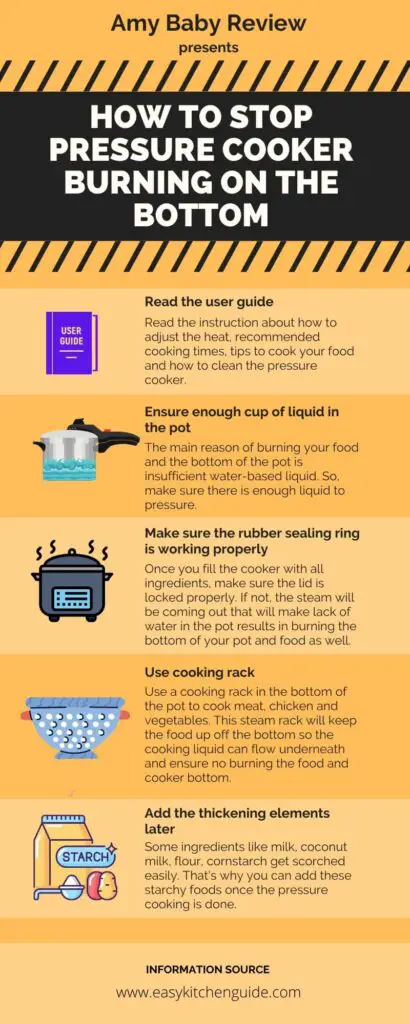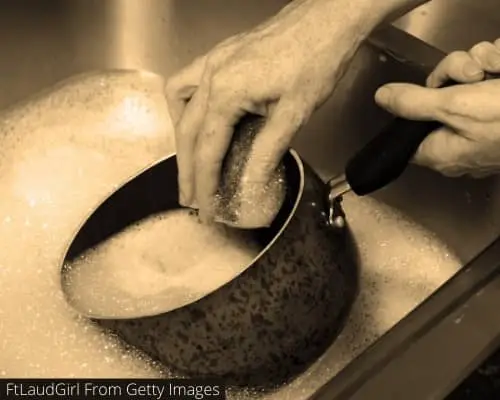Are you facing the same problem that I faced when cooking in a pressure cooker? Whatever I cooked stuck to the bottom of the pot that eventually burnt my cooker. If you’re facing the same issue and desperately want to know how to stop pressure cooker burning on bottom, this guide is for you.
The simple tricks I followed helped me stop burning my cooker on the bottom and cook the food nicely. So, if you follow the same tricks, you’ll also get relief from burning the pressure cooker’s bottom. So, continue reading!
Why does my pressure cooker burn on the bottom?
If the pressure cooker burns bottom, there is uneven heat distribution. But the pressure cookers that were released in recent years provide equal heat distribution. Yet, the food is burning and sticking to the bottom.
It’s because once you load the cooker with food, you have to seal the pot. So, you can’t stir the food. When there is short of water-based liquid in the pot, the cooker might become overheated, and then guess what?
The food starts sticking to the cooker’s base, which eventually burns the bottom of the pressure cooker.
If you’re using an induction stovetop for cooking food, check out our Easy Kitchen Guide’s expert picks of the best pressure cookers for induction. These pressure cookers are designed specifically for induction cooktops and do not burn food.
How to stop food from burning on the bottom?
I’ve described some key points below. If you follow these notes when cooking in a pressure cooker, you can minimize your food and pot’s burning. Let’s check them out:

Read the user manual On how to stop food burning on the bottom:
You should read the user manual of your pressure cooker though it seems like a tedious task. It’s because you will find some helpful information in it about the cooker.
For example, it could be the instructions about adjusting the heat, recommended cooking times, tips to cook your food, cleaning process, and so on.
These guidelines will help you prepare the food better and prevent pressure cooker burnt bottom.
Don’t forget that every pressure cooker’s cooking time might differ depending on the brand, size, materials it is made from, and the cooktops you’re using.
So, if you don’t read the manual thoroughly, you might end up burning your meals as well as the bottom of your pot.
Ensure enough cups of liquid in the pot:
When you have sufficient cooking liquid in the pot, it can produce enough steam that creates pressure to cook the food in a quick time.
But if there is not adequate water-based liquid to pressure in the pot, it becomes an overheating error that results in burning the food and the bottom of the pressure cooker.
Make sure the rubber sealing ring is working correctly:
After putting all ingredients in the pressure cooker, you have to close the lid properly. Make sure the silicone sealing is placed perfectly, or it should work decently.
Otherwise, the steam will be coming out on a regular basis, and there will be a lack of liquid to pressure. So, the food and the bottom of the pot will get burned.
Use cooking rack:
Using a cooking rack in the pot’s base to cook chicken, meat, and vegetables is a fantastic idea to stop burning to your pressure cooker bottom and get well-cooked meals.
The steam rack will keep the food up off the bottom so the cooking liquid can flow underneath. It will ensure the dish cooks well from everywhere without burning and preserving your food’s vitamins and minerals.
Use the cooker as a pressure canner:
When you need to cook cream-based sauce, fruits, jams, jellies, pickles, and so on, you can use the cooker as a pressure canner.
Put a steam rack on the bottom of the pot and place all the cans. This method will also prevent burning your cooker and food.
Add the thickening elements later:
Some ingredients like milk, coconut milk, flour, and cornstarch get scorched easily. That’s why you can add these starchy foods once the pressure cooking is done.
But before doing so, you have to make sure there is sufficient water in the pot to pressure cook fruitfully.
How to Clean a Burnt Pressure Cooker Pot?
I’ll show you a super easy pressure cooker hack to clean a scorched, burnt-deep layer of dark brown cement from your pressure cooker pot.

“Before I knew this trick, I had to do a lot to clean the burnt pot. I left the pot to soak the dishwasher for the whole night, then the next day scrubbing it for hours with a heavy-duty metal scrub sponge. Still, the scorch mark was found in the pot.”
But when my friend Megan showed me the following method, I could deep clean the burnt pressure cooker in minutes. So, let’s reveal the deep cleaning process:
Depending on the scorching level, add some baking soda and dishwashing soap to the pot (I add one tablespoon each), then half-filled with water.
After that, close the lid properly and pressure cook them for 5 minutes. When you remove the top, you’ll see a nasty brown layer floating in the soapy water, which is gross.
Then make the pot empty and wipe away the extra stuck-on residue with a paper towel (if there is any). Next, quickly scrub for 5 seconds and rinse well. The pot will shine with sliver sun rays.
FAQs
Why does food stick at bottom of pressure cooker?
Food sticks at the bottom of the pressure cooker because it is exposed to high temperatures for a long period of time, causing food particles to caramelize and adhere to the surface.
Additionally, steam can help concentrate sauces and juices that may contain sugar or starch, further aiding in sticking.
Finally, if there is not enough liquid added to a pressure cooker, the bottom of the pot may become too hot for the food not to stick.
To prevent this, ensure you add enough liquid and occasionally stir during cooking to keep the food from sticking. For instance, a successful ratio when preparing rice or lentils is 1.5 cups water for every cup you intend to cook.
What happens if you pressure cook without liquid?
It cannot cook your food properly without water, and the pressure will build to such an extent that the lid, pressure valve, plugs, and hot food could be thrown all over the kitchen. This can seriously harm you, your kids, and your pets, not to mention property damage that comes from flying projectiles.
Pressure cooking without liquid can lead to various problems, including burned food, uneven cooking, and the risk of the pressure cooker exploding.
Without liquid, there is no steam for the heat to transfer and cook the food, so it will become dry and potentially burned.
Additionally, when too little or no liquid is present in the pressure cooker, the pressure can build up too quickly and cause the cooker to explode.
Therefore, it is essential to always use at least a cup of liquid when pressure cooking. The type of liquid used depends on the food you are cooking; it could be water, broth, wine, or something else.
Additionally, some foods may require other ingredients, such as oil to help cook the food evenly. When in doubt, it is always best to consult a pressure cooker recipe for exact instructions.
What should you not put in a pressure cooker?
You should avoid putting foods that are very delicate, such as fish, oysters, shrimp, muscles, clams and eggs, as they can easily overcook when exposed to the high levels of heat and pressure within the cooker.
Additionally, you should never fill the cooker more than two-thirds full as it could cause a dangerous situation if the food expands and blocks the pressure release valve.
The wrap-up:
Thanks for reading the complete guide about how to stop pressure cooker burning on the bottom. I hope you’ve found this article helpful and informative.
To sum up, I just want to mention that the method I’ve shared above helped me stop burning my food and cooker almost 100%. So, I believe if you follow the same formula, you’ll also get the best result.
My name is Lori Walker. I’m a registered dietitian, food blogger and food enthusiast. I share easy healthy, delicious recipes on my blog and review necessary kitchen items. The recipes I share take less… Read more
